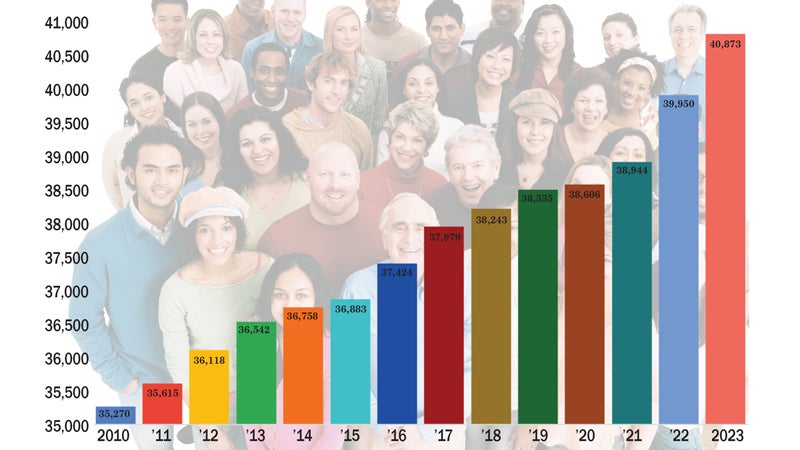Isle of Wight now Virginia’s sixth fastest-growing county, Weldon Cooper data shows
Published 9:20 am Tuesday, February 20, 2024

- Isle of Wight County’s population has grown roughly 2% on average over the past three years, making it the sixth fastest-growing county according to Weldon Cooper data. (Jen Jaqua | The Smithfield Times)
Isle of Wight County, for the second consecutive year, remains one of Virginia’s top 10 fastest-growing localities.
Population estimates the University of Virginia’s Weldon Cooper Center released Jan. 30 for each of the state’s 133 cities and counties list 40,873 people living in Isle of Wight as of mid-2023. The nearly 6% increase from the 38,606 counted during the 2020 Census makes Isle of Wight the sixth fastest-growing county and the eighth fastest-growing locality, including cities.
Last year’s census update showed Isle of Wight in seventh place among counties and ninth among counties and cities.
The Census Bureau, which has not yet released this year’s update, last year estimated Isle of Wight’s population at 40,151 based on mid-2022 data. Weldon Cooper’s prior-year data, by comparison, listed 39,950.
“The numbers tend to be different,” Weldon Cooper demographer Hamilton Lombard acknowledged.
Weldon Cooper’s methodology differs from the census in counting college students as residents of their home locality rather than the city or county where their school is located. The census is also limited in what state-specific data it can use due to needing uniform criteria for measuring population across all 50 states, Lombard said.
Another factor Weldon Cooper and the census both examine is each locality’s birth rate and net migration, which refers to the number of people moving in, minus those moving out. Isle of Wight saw 180 more deaths than births since the 2020 Census, according to Weldon Cooper’s data, but saw 2,447 more people move into the county than out.
According to the Weldon Cooper data, 2023 was the second consecutive year Isle of Wight saw its population grow more than 2% annually. Isle of Wight previously saw four consecutive years of 2% annual growth from 2004 to 2007 at the height of a booming housing market that collapsed when foreclosures on high-risk or “subprime” mortgages had by 2008 spurred a nationwide economic crisis now known as the Great Recession.
In 2005, when now-established developments like Eagle Harbor and Founders Pointe in Carrollton were building out, Weldon Cooper identified 524 new houses permitted that year in Isle of Wight. In 2022, the most recent year for which Weldon Cooper was able to obtain local permitting data, there were 514.
“When you look at construction data for Isle of Wight, there seems a very similar trend,” Lombard said.
Interest rates for an average 30-year fixed mortgage are at 6.6% this month, up from roughly 3.8% two years ago, according to Freddie Mac, a government-controlled company that provides money for the U.S. housing market by buying residential mortgages. But that doesn’t seem to be slowing demand among buyers.
“There hasn’t been a huge falloff,” Lombard said.
One factor different from those that fueled the early 2000s housing boom, Lombard said, is the emergence of remote work during the early days of the COVID-19 pandemic. The continued availability of flexible working arrangements using internet-based teleconferencing platforms like Zoom may be driving workers unconcerned with commuting distance to more rural localities.
“I think that’s why you’re seeing so much growth in Isle of Wight,” Lombard said.
The consequences
Virginia uses Weldon Cooper’s annual population estimates, and a separate school-age population estimate, to proportionally allocate each city and county its share of state revenue. Among these state formulas is the “composite index,” which the state uses when allocating money to public school divisions. According to the Virginia Department of Education, the formula is intended to measure a school division’s “ability to pay” the cost of meeting state-mandated minimum staffing levels based on enrollment, adjusted gross income and tax revenue.
“Essentially it’s looking at the ratio of resources to population,” Lombard said.
If school enrollment is increasing but a locality’s tax base isn’t keeping pace, the locality becomes eligible for more funding, Lombard explained.
A separate study unrelated to the allocation of state revenue that Weldon Cooper released in mid-January had projected Isle of Wight County Schools’ enrollment would grow only 2% through 2029, but didn’t take into account building permits and pending rezoning applications.
In 2023, Isle of Wight saw seven rezoning applications for new and expanded housing developments that would collectively add over 1,900 houses to the county’s northern end. Another 2,200 new northern-end homes are tied to eight developments approved prior to 2023.





